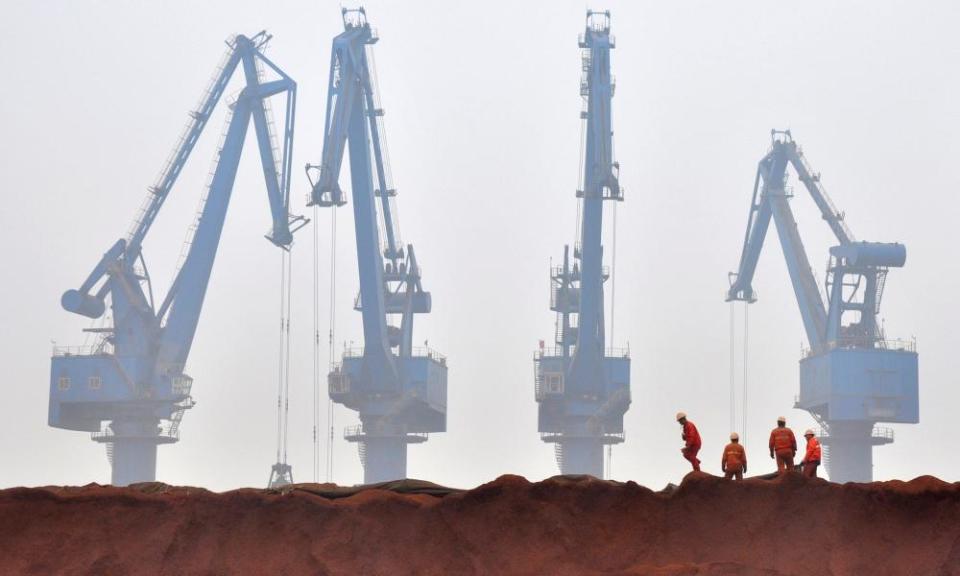Australia's buoyant exports are good news for GDP – but less so for households

The latest figures from the Bureau of Statistics show that even amid the trade argy-bargy with China, our exports are generally doing well. But the figures also reveal the disconnect of our exports from the domestic economy and jobs.
The news that China was slapping an 80% tariff on Australian barley not surprisingly sent large shockwaves through the agricultural sector. In 2018-19 just over $1.8bn worth of barely was exported – second only to wheat among farm crops.
While that is just under 4% of all rural exports, you can understand why farmers would be getting rather worried.
And the noises China is making about our coal exports are not particularly pleasing either, given that while our farm exports are large, they are relatively minuscule compared with the non-rural sector.
The entirety of all rural exports in the past 12 months was worth $47bn, while coal exports alone were worth $60bn and iron ore was $130bn.
The total value of rural exports now comes well behind not only that of non-rural goods but also services:
Exports as a whole are more important to Australia than they ever have been. The value of our exports is now bigger than that of the entire domestic private sector (excluding households).
In the December quarter of last year, the total volume of spending and investment by the non-household private sector was worth $84.9bn compared with the $107.1bn worth of exports:
Indeed, our exports now account for a quarter of our economy – well up from the 20% at the start of the century and double the level they were in the 1960s and 1970s.
And of course the big reason is iron ore and China.
Related: Australia relaxed over China's changes to iron ore export rules, but war of words goes on
Consider that at the end of the 20th century the value of our iron ore exports was essentially the same as that of the traditional south-western Australian farm product of cereals and wool. Now the value of our annual iron ore exports is 14 times that of what we export in cereal and wool:
And China is the big buyer.
China now buys as much of our merchandise exports as do the next seven biggest buyers combined:
We sell more to China than we do to the entire 36 other countries in the OECD combined.
And our large growth of iron ore exports has been greatly responsible for keeping our economy afloat over the past decade:
Over the past five years, the domestic private sector actually reduced the size of Australia’s economy. Coupled with that was a shrinking household sector – where due to stagnant wages and incomes, household spending was contributing less and less to growth despite making up around 55% of the entire economy.
The buoyancy of our exports, along with the increased government spending largely through the NDIS, had been keeping our economy out of recession.
And yet even now, in the midst of the Covid-19 shutdown, we still look to exports to keep the economy somewhat afloat.
That is why it is cheering that the Bureau of Statistics’ preliminary survey of merchandise exports see things mostly holding up.
The figures are rather erratic and not seasonally adjusted, but while there was a drop in the total amount of exports in April compared with March, iron ore, cereals, gas and meat all show higher export values than a year ago:
Now, there is sure to be some lag-effects from the virus hitting overseas but the ABS notes “Australian exports remain strong due largely to ongoing demand for Australian resource commodities, in particular iron ore from major trading partners across Asia, and gas.”
So that is good news for our GDP, and yet not necessarily for households.
While these latest trade figures looked at our merchandise exports they do not include the services sector. For that we need to go back to the March figures released earlier this month.
In March the value of our services exports fell 9.4%, coming off the back of an 8.5% fall in February. All told, the value of services sector exports in March were 20% below what they were in November:
And this is where the real problem for workers hits home.
Mining exports may generate masses of revenue, but they require relatively few workers.
The mining sector accounts for nearly 10% of the total economic activity of all our industries, but employs just 1.9% of all workers. By contrast the accommodation and food services industry produces just 2.4% of all economic activity, but employs 7.2% of all workers:
It takes around 84 people employed in accommodation and food services to produce the same amount as five workers in the mining sector.
And that is why as we go forward and see our GDP bounce around for good and ill, the key will be instead to look at how workers are doing – because if the services sector continues to shrink, even while iron ore exports thrive, GDP and employment may tell wildly divergent narratives.
• Greg Jericho writes on economics for Guardian Australia

 Yahoo News
Yahoo News 